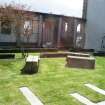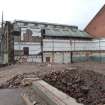Notice
Following a review of the Buildings at Risk Register we have paused the Register while we consider options for its future.
The website will remain accessible and searchable during this time, but it will not be updated and we’re not accepting nominations for additions to the Register. If you need to contact us about the BARR please email hmenquiries@hes.scot
Read the review report here and you can find out more about why we have paused the BARR on our news centre.
Bruce Street Baths and Swimming Pool, Bruce Street, Clydebank
Ordnance Survey licence number AC0000807262. All rights reserved. © Copyright and database right 2025. Public Sector Viewing Terms
Useful Links
- Canmore:
- CLYDEBANK, BRUCE STREET, PUBLIC BATHS & SWIMMING POOL
- Historic Scotland:
- HS Reference No 51432
General Details and Location
Category
AT RISK
Name of Building
Bruce Street Baths and Swimming Pool
Other Name(s)
Address
Bruce Street, Clydebank
Locality
Postcode
Planning Authority
Divisional Area
Reference No
4297
Listing Category
C
OS Grid Ref
NS 49557 70094
Location Type
Urban
HS Reference No
51432
Description
Stylised Baroque Public Baths with adjoining 3-bay Swimming Pool to left (currently disused, 2009). Sandstone ashlar. Base course, band course, cornice. Rusticated, key-stoned openings. Public Baths with round-arched entrance openings and segmental arched window openings to ground. Bracketted cills to ground; narrow aprons to upper storey windows. 1960s tiled blank extension to right.
This is a good example of a now rare building type of public baths with an adjoining swimming pool complex. Once a relatively common building type in urban Scotland, public baths have become obsolete and modern leisure centres have largely replaced traditional swimming pools. It is an important streetscape feature and it was purposefully designed to match the style of the earlier, 1902 Municipal Buildings in Dumbarton Roadby the Glasgow architect James Miller. Together, the buildings form the major part of a complete block and form a coherent civic heart in Clydebank Public baths and swimming pools grew in popularity particularly in the second half of the 19th century and most of the surviving ones date from this period; some with intricately decorated interiors. Many people had no access to running water in the home and public health was becoming an increasingly important issue. In 1846, the Act to Encourage the Establishment of Public Baths was passed and the majority of public baths began to be built after this time. Built in the 1930s, this is a relatively late example and probably indicates that there were still a significant number of homes in Clydebank at this time with no bathing facilities. The Bruce Street Baths was designed to replace the nearby Hall Street Baths (now demolished) which were becoming too small. The plans were approved by the Council in 1929 and the baths were opened in 1932. It originally had a variety of facilities, including Turkish Baths, Russian Vapour Baths, a laundry and a massage room. (Historic Scotland)
This is a good example of a now rare building type of public baths with an adjoining swimming pool complex. Once a relatively common building type in urban Scotland, public baths have become obsolete and modern leisure centres have largely replaced traditional swimming pools. It is an important streetscape feature and it was purposefully designed to match the style of the earlier, 1902 Municipal Buildings in Dumbarton Roadby the Glasgow architect James Miller. Together, the buildings form the major part of a complete block and form a coherent civic heart in Clydebank Public baths and swimming pools grew in popularity particularly in the second half of the 19th century and most of the surviving ones date from this period; some with intricately decorated interiors. Many people had no access to running water in the home and public health was becoming an increasingly important issue. In 1846, the Act to Encourage the Establishment of Public Baths was passed and the majority of public baths began to be built after this time. Built in the 1930s, this is a relatively late example and probably indicates that there were still a significant number of homes in Clydebank at this time with no bathing facilities. The Bruce Street Baths was designed to replace the nearby Hall Street Baths (now demolished) which were becoming too small. The plans were approved by the Council in 1929 and the baths were opened in 1932. It originally had a variety of facilities, including Turkish Baths, Russian Vapour Baths, a laundry and a massage room. (Historic Scotland)
Building Dates
Opened 1932
Architects
Master of Works, Clydebank Council
Category of Risk and Development History
Condition
Fair
Category of Risk
Moderate
Exemptions to State of Risk
Field Visits
25/03/2010, 8/2/2011, 23/4/2013, 03/09/2021
Development History
December 2009: Clydebank Post reports on a campaign to save Bruce Street Baths from demolition. The articles goes on to note that the planned demolition is part of the Civic Heart plans by WDC and Clydebank re-built.
January 2010: Clydebank Post reports that the swimming pool part of the complex may be listed by Historic Scotland. Clydebank Restoration Trust hope this may save the Bathhouse building.
March 2010: External inspection confirms the building is vacant (the Baths are understood to have closed 1985) On ground floor level, openings have been bricked up and windows grilled. There are significant damp patches on the Bruce St elevation.A summary condition report, submitted with the recent planning application, notes deterioration in the reinforced concrete-framed Pool, but that the rest of the Hall appears to be sound. Of the Baths section, there is an issue of water ingress, but condition is fair at this time.
April 2010: The Clydebank Post reports permissions have been granted, with conditions, for the redevelopment of the Town Hall which includes the formation of a garden on the site of the slipper baths. The article notes a number of conditions were attached to the application, including that Historic Scotland grants listed building consent.
April 2011: Local planners advise the former slipper baths in were demolished at the end of 2010. The adjoining swimming pool hall remains and is receiving some building repairs as part of the Town Hall redevelopment, with the intention that it be available for conversion to civic purposes once funding is available.
8 February 2012: External inspection frinds the former public baths section has been demolished other than the ground floor facade. The swimming pool half appears to be in fair condition. The most obvious problem is a large damp area adjacent to the demolished section.
23 April 2013: External inspection finds the partially retained facade of the former public baths has been consolidated and a garden created to the rear. The former baths do not appear to be changed from the last site visit.
31 July 2013: West Dunbartonshire Council advise the site remains in their ownership as part of the former town hall/ civic complex. In the short term it is hoped to create a small scale viewing gallery into the former swimming pool, potentially featuring one of the retained original changing rooms. In the longer term the Council would like to convert the building, possibly into an arts workshop/ exhibition space, to sit alongside the new museum and gallery within the former Town Hall subject to securing the necessary funding.
6 December 2019: A member of the public notes consent for temporary use as exhibition space at the complex was conditionally approved in 2017 (DC17/058).
3 September 2021: External inspection finds the former pools remain disused. Limited inspection was possible of the north elevation due to the redevelopment of the streets adjacent. The principle concern for the building fabric remains with the dampness evident to the Bruce Street principle entrance. Dampness to the southern-most section has increased since the previous visit reaching across towards the ground floor openings with efflorescence evident. Some minor vegetation growth to windows was observed and a buddleia is established within the band course where joints are opening. The barrel-vaulting to the pool appears to be intact albeit with some limited vegetation growth establishing. The gabled rooflight's glazings remain intact. Rainwater goods are concealed and could not be assessed. A brick building to the south of the site has been removed since the previous site visit as has a ramped access.
Guides to Development
Conservation Area
Planning Authority Contact
PAC Telephone Number
01389 738794
Availability
Current Availability
Unknown
Appointed Agents
Price
Occupancy
Vacant
Occupancy Type
N/A
Present/Former Uses
Name of Owners
West Dunbartonshire Council
Type of Ownership
Local Authority
Information Services
Additional Contacts/Information Source
Bibliography
Online Resources
Classification
Baths and Swimming Pools
Original Entry Date
07-DEC-09
Date of Last Edit
31/07/2013

















